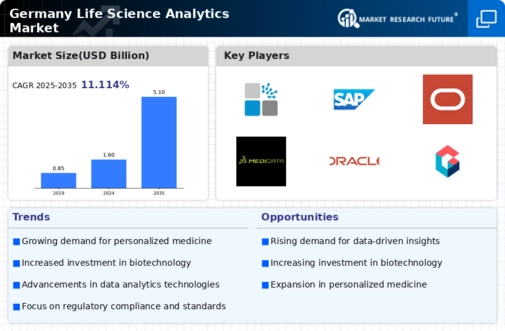The life science-analytics market in Germany is characterized by a dynamic competitive landscape, driven by innovation, technological advancements, and strategic partnerships. Key players such as Thermo Fisher Scientific (US), Roche Holding AG (CH), and Merck KGaA (DE) are at the forefront, each adopting distinct strategies to enhance their market positioning. Thermo Fisher Scientific (US) emphasizes innovation through continuous investment in R&D, focusing on advanced analytics solutions that cater to the evolving needs of the life sciences sector. Meanwhile, Roche Holding AG (CH) leverages its strong portfolio in diagnostics and pharmaceuticals, aiming to integrate analytics into personalized medicine, thereby enhancing patient outcomes. Merck KGaA (DE) is also notable for its commitment to digital transformation, seeking to optimize its operations through data-driven insights and analytics, which collectively shape a competitive environment that prioritizes technological advancement and customer-centric solutions.
The business tactics employed by these companies reflect a concerted effort to localize manufacturing and optimize supply chains, which are crucial in a moderately fragmented market. This competitive structure allows for a diverse range of offerings, with key players influencing market dynamics through strategic collaborations and innovations. The collective influence of these companies fosters a robust ecosystem that supports growth and adaptability in the face of changing market demands.
In October 2025, Roche Holding AG (CH) announced a strategic partnership with a leading AI firm to enhance its data analytics capabilities. This collaboration aims to integrate AI-driven insights into its diagnostic processes, potentially revolutionizing how patient data is analyzed and utilized. The strategic importance of this move lies in Roche's commitment to staying at the forefront of personalized medicine, ensuring that it can deliver tailored solutions that meet the specific needs of patients and healthcare providers alike.
In September 2025, Thermo Fisher Scientific (US) launched a new cloud-based analytics platform designed to streamline laboratory workflows and enhance data accessibility. This platform is expected to significantly improve operational efficiency for laboratories, allowing for real-time data analysis and decision-making. The introduction of this technology underscores Thermo Fisher's focus on digital transformation and its intent to lead in the provision of innovative solutions that address the complexities of modern life sciences.
In August 2025, Merck KGaA (DE) expanded its analytics services by acquiring a data analytics startup specializing in biostatistics. This acquisition is poised to enhance Merck's capabilities in providing comprehensive analytics solutions to its clients, particularly in drug development and clinical trials. The strategic importance of this acquisition lies in its potential to bolster Merck's competitive edge by integrating advanced analytics into its service offerings, thereby improving the efficiency and effectiveness of its research and development processes.
As of November 2025, the competitive trends in the life science-analytics market are increasingly defined by digitalization, sustainability, and the integration of AI technologies. Strategic alliances are becoming more prevalent, as companies recognize the value of collaboration in driving innovation and enhancing service delivery. Looking ahead, competitive differentiation is likely to evolve from traditional price-based competition to a focus on innovation, technological advancements, and supply chain reliability. This shift indicates a market poised for transformation, where the ability to leverage cutting-edge technologies and maintain robust partnerships will be critical for success.






















Leave a Comment